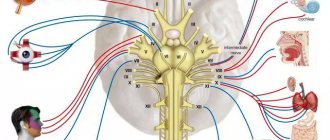Dissociation is a phenomenon related to psychological defense tools. The result of the operation of this mechanism is a person’s perception of the events happening to him, as if they were happening not to himself, but to someone else. Such a dissociated position protects against excessive, unbearable emotions. Thus, the concept of dissociation means a completely natural process that helps a person survive under the influence of serious stressors, when he has a lack of resources for emotional involvement. Dissociation is transformed into pathology when the described security process is used constantly as a behavioral pattern.
What is dissociation
Dissociation is the breaking apart of something into its components. Derived from the Latin word dissociatiodissociatio, which means division.
In psychology
In psychology, the term was introduced by the French psychologist P. Janet (late 19th century). He managed to prove that individual thoughts can exist outside a person’s consciousness and can only be realized under hypnosis.
Dissociation in psychology is the primary defense mechanism of the psyche. Protects against shocks, injuries, negative emotions. In a state of dissociation, it seems to a person that the events did not happen to him. He takes the position of an outside observer, abstracts himself.
The specificity of the phenomenon is that a person can separate both negative and positive emotions from himself if they cause a state of distress. For example, strong love feelings interfere with working, thinking, and living. Sometimes a person tries to abstract himself from them.
There are two types of personality dissociation:
- Positive. The individual abstracts himself from events in order to soberly assess the situation and protect himself from destructive feelings.
- Negative. Due to excessive sensitivity, the individual perceives an ordinary situation as dangerous and withdraws through dissociation. This interferes with adaptation and spoils relationships with others.
People who have experienced dissociation describe it with the following phrases:
- “It’s like it’s not happening to me”;
- “The feeling that these feelings are not mine”;
- “My feelings seem to live separately from me.”
In cases where the norm borders on pathology, a person sees himself from the outside, feels dissociation as a way out of the body.
In psychiatry
In psychiatry, personality dissociation refers to the unconscious separation of thoughts and beliefs from awareness. For example, a person holds two contradictory views on the same problem. Without correction, the condition can trigger the development of dissociative identity disorder or the flight response. The phenomenon of dissociation and multiple personality syndrome develops in people who have suffered severe psychotrauma. The risk of developing abnormalities increases if we are talking about childhood psychological trauma, for example, violence.
Preface
In psychiatry there is a group of diseases called “dissociative disorders”. Compared to paranoia or schizophrenia, it probably doesn’t sound very scary, but it is a fairly serious diagnosis. What is it? Dissociation in Latin means “disintegration.” With this disease, mental functions such as memory, consciousness, and a sense of personal identity are impaired. These mental functions are separated from the holistic stream of consciousness and become independent. Thus, the integrity of the individual is violated.
Dissociation: examples
Every time we try to forget about some feelings and emotions, to stop feeling it, we use dissociation. We try not to think about what upsets, saddens, scares or hurts us.
Example of dissociation:
- The person who survived the attack says that at that time he did not feel pain. Or he says that he saw himself as if from the outside.
- A client in a session with a psychologist talks about rape as if it were the plot of a book. There are no emotions on his face, his pulse does not quicken, his blood pressure does not rise.
One of the most famous examples of pathological dissociation is Billy Milligan, a murderer and rapist with 24 personalities. They all have different gender, age and character. In this case, dissociation became the basis for the development of multiple personality disorder. By switching between personalities, Billy's subconscious protected him from suicide and old psychotrauma. Perhaps the impetus for the development of the mechanism of dissociation, and then the disorder, was the violence to which Billy was subjected in childhood.
Dissociative disorder
When people chronically dissociate and it disrupts their lives, they may be diagnosed with dissociative disorder. There are several dissociative disorders, and it is important to know that these classifications may not completely describe any person; in fact, dissociation still needs to be studied. There is general agreement, however, that major complex dissociative separations typically develop in childhood. They are the result of failures in the integration of the child’s personality, the consequences of which are present in adulthood.
Dissociation: norm and pathology
It is customary to distinguish between normative and pathological dissociation. In the first case, we are talking about a natural defensive reaction to stress, shock, and unpleasant experiences. Dissociation normally occurs in difficult situations, where a person is required to maintain composure, restraint, and rationality, but he cannot consciously pull himself together. Then an unconscious process is activated - a protective mechanism of the psyche. As a result, a person gains an advantage over the situation, can soberly assess it and make a rational decision. In this case, dissociation can be seen as a means of adaptation rather than as a defense mechanism.
In the pathological form, a person dissociates in any emotional situations, and not just in difficult life circumstances. Such people are called thick-skinned, indifferent, cold, callous, unemotional. They exclude any negativity, refuse to resolve conflicts, and are not ready for productive social interaction. This behavior can lead to isolation.
How do different groups of substances dissociate?
Dissociation of acids
Leads to the formation of hydrogen cations H+ and negatively charged acid residues:
HCl = H+ + Cl-
H2SO4 = 2H+ + SO42-
HNO2 ⇄ H+ + NO2-
Polybasic acids dissociate stepwise:
- AlOHCl2 = AlOH2+ + 2Cl-
- AlOH2+ ⇄ Al3+ + OH-
Base dissociation
Occurs with the formation of hydroxyl groups OH- and positively charged metal ions. Strong electrolytes in solutions dissociate completely, while weak electrolytes dissociate stepwise and reversibly.
Strong reasons:
NaOH = Na+ + OH-
Weak grounds:
- Cu(ON)2 ⇄ CuOH+ + OH-
- CuOH+ ⇄ Cu2+ + OH-
Dissociation of salts
Leads to the formation of metal cations (or ammonium cation) and negatively charged acid residues.
Medium salts in solutions completely disintegrate in one step.
Na3PO4 = 3Na + PO43-
Acidic salts decompose in stages. At the first stage, metal cations are separated, and at the second, hydrogen cations are separated.
- KHSO4 = K+ + HSO4-
- HSO4- ⇄ H+ + SO42-
Basic salts also dissociate in two steps. At the first stage, acidic residues are separated, followed by hydroxyl groups OH-.
- MgOHBr = MgOH+ + Br-
- MgOH+ ⇄ Mg2+ + OH-
Dissociation and Association
Association and dissociation are two opposing processes. With association, a person is involved in some situation, with dissociation, he is detached. Our memories can be either associated or dissociated. Moreover, we ourselves can choose what they will be. This technique is used by psychotherapists. The more involved in something (association), the more acutely you feel a certain situation, a specific emotional state. The less you are involved in some memories (dissociation), the easier it is for you to objectively analyze the situation and learn a lesson from it.
Dissociation and association are two forms of perception of external information. With association, we actively participate in the analysis of the situation, realize it, comprehend it, and experience it. For example, when watching films, many people are completely immersed in the picture and feel what is happening for themselves. With dissociation, a person analyzes the situation from the outside, look at it from the outside, and not from the inside.
In life, we regularly choose one or another type of perception. If a person becomes fixated on one type, then this is an alarming signal. This indicates rigidity of consciousness.
Getting stuck in a state of association leads to victimization of thinking. A person takes everything to heart and plays the role of a victim. Being stuck in a state of dissociation leads to emotional coldness. The individual becomes unable to enjoy life and his successes. He can't show empathy.
Being stuck in one of the states puts a person at risk for chemical dependency. Alcohol and drugs help you “switch.” The individual quickly recognizes this and uses this method as “treatment”.
Being stuck in a state of dissociation leads to emotional coldness. The individual becomes unable to enjoy life and his successes.
Diagnosis of mental illness
This behavioral personality disorder is quite difficult to diagnose, especially in its initial stages.
Common points that psychologists and psychiatrists pay attention to are:
- not the individual behavior of the patient - manifestation in the actions and speech of different personalities (2 or more). It is quite difficult to understand at an early stage whether there really are disturbances or whether the person is simply not in the mood. At later stages, it is easier to identify diverse behavior - individuals can consider themselves to be of the opposite sex, express extreme and previously uncharacteristic views on life;
- changeable behavior - occurs due to the fact that one personality replaces another. Most often this happens by a conditioned signal (in each specific case this signal will be individual);
- partial amnesia - it is useless to explain to a person with a dissociative disorder that just a couple of days ago he perceived this or that situation differently, simply because it was not him, but another person;
- the influence of synthetic substances - alcohol, drugs, nicotine in people suffering from this disorder causes a dramatic change in mood. We can say that existing bad habits in people with dissociative disorder serve as the same signal for activation of the disease as severe stress or pleasure.
In addition to these signs, with this deviation there may be other purely individual manifestations of the disorder, which are more likely to be noticeable to loved ones of a person suffering from a dissociative disorder. This condition can often be confused with a form of schizophrenia, which is also characterized by personality disorder, but with schizophrenia, patients do not experience memory loss.
Dissociation in psychotherapy (techniques)
Psychotherapy begins with the client's acceptance and awareness of the problem. Without this, healing is impossible. The client must realize that only he is responsible for any situations and changes in his life. And for this, a person needs to dissociate, separate the problem from his Self. So far, hypnosis has been recognized as the best way. The specialist helps the client realize what he has long separated from himself.
To learn how to switch from associations to dissociations, you need to identify personal triggers (external factors that turn on a defense mechanism). As soon as you feel a trigger approaching, begin to analyze your state and consciously direct it in the right direction.
Let's take a closer look at several dissociation techniques in psychology. They help to distance oneself from traumatic circumstances.
I see, I hear, I analyze
In order to move away from the situation and pacify emotions, you can use one of the following formats, but it is better to use all three at once.
View from the outside:
- Stop mentally, get out of your body and look at yourself, other people and the situation from the outside. Avoid value judgments, state the facts.
- Imagine the image in black and white.
- Zoom out the picture and move it away from you, as if you were doing it on a smartphone display.
- Move into the background those people who cause you negative emotions.
- Imagine you are watching a movie. Play the “video” faster or slower.
- Imagine what this situation, events, participants will look like in 20–30–40 years. Do you think it makes sense to worry the way you originally did?
Auditory format:
- Imagine listening to other people and yourself through your phone or speaker.
- Imagine how the volume of each voice, or just those that annoy you, decreases.
- Change your annoying voice, for example, make it squeaky. Play with the speed of your voice.
Analytical format:
- Imagine that you are watching what is happening from the outside. This time, not only study the facts, but also give your assessment of what is happening.
- “Convey” your emotions to the one you are looking at.
- Analyze the situation according to plan: who, what, why and why.
- Imagine different scenarios for the development of the situation.
- What should you do to turn the situation in your favor?
We don’t know how to experience and think at the same time, so while you imagine something and analyze the situation, emotions fade away. Practice the techniques regularly and switching will become easier each time.
X-ray (NLP)
Goal: to achieve a relaxed and calm state, humility, peace, slight sadness. Alternative names for the technique: Memento mori (remember death), Danse macabre (dance of death).
What to do: imagine yourself and those people who are involved in the traumatic event in the form of skeletons (as in an x-ray). NLP specialists believe that this will be enough to realize that all the difficulties, failures, and worldly vanity are trifles. At first you will feel slight sadness, then forgiveness, humility, peace.
Visual-kinesthetic dissociation
Using this method, you can work through psychotrauma. This is a complex technique that is best performed under the supervision of a psychologist.
What to do:
- Imagine that you have stepped away from the situation and looked at it from the outside. You see yourself at the starting point of the development of traumatic circumstances. At the same time, you understand that you are in the present moment, and you see yourself at that point as on a slide.
- Now once again separate your consciousness from your body and imagine that you are observing your younger self (at the beginning of the trauma) and your present self. Triple separation is necessary so that you stop feeling and seeing yourself as a direct participant in events.
- Replay the trauma, maintain kinesthetic detachment. You observe your younger self, the reactions and feelings of that person.
- Having looked and listened from the outside, first enter the image of yourself that we received in the first point (you are from the one who observed everyone, enter the body of the one who observed himself at the beginning of the injury).
- In your thoughts, approach yourself in a traumatic situation. Say that you come from the future and are ready to help. Give your younger self what he needs at this moment.
- As soon as you understand that the young you has calmed down, satisfied your desires, received the right amount of support, enter this image, and then transfer it to the image of your current self. This will help you accept the past, change your attitude towards it, and gain integrity.
In some cases, one point has to be performed 2-3 times. It is important that the person maintains a state of dissociation. To get rid of trauma, you need to maintain the position of an outside observer.
Where does it all begin?
When a child is born, he has no self-identity and does not separate himself from his mother. Gradually he begins to look around, see himself, raise his head and see the environment, grab objects and walk. By studying the world in this way and comparing himself with it, the child eventually realizes himself as something separate from the whole world. It is at this time that the first thoughts about death begin to arise in him, because the previous connections “I = mother” and “I = the world around” are destroyed, and he becomes an isolated being. At this age, the mother, when talking about the child, often still uses the pronoun “we” (“we walked,” “we ate,” “we pooped”) and this is normal. But around the age of 5, the moment comes when the mother must begin to stimulate and support the separation process, and this is first done through speech. When talking about a child, you should now say “he” or “she” (naturally, in the presence of the child or when addressing him, call him by name), thereby teaching the little person to understand that he is a separate person. Then you need to gradually delegate to him responsibility for his own actions and decision-making. You can start with the child mastering basic self-care skills (dressing, etc.). It is important to encourage his independence - this means praising him, even if he did not succeed. Your own example is also very important. Sometimes it seems that parents think their children are idiots, deaf or blind, when they are much smarter than they might seem. The child's psyche is very flexible, it instantly absorbs and integrates everything that happens around it, and this happens several times faster than in an adult. The child is more spontaneous, open to the world and trusting. So if you promise something, do it. If it doesn't work out, explain to your child why. Take responsibility for your actions and decisions. Don't deceive or manipulate: children understand very well if you explain to them and feel when they are being manipulated. Be honest yourself, and you won’t have to reap the fruits of your deception and manipulation when a child “behaves like this for someone who doesn’t understand” or in adolescence loses trust in his parents (in modern Soviet psychology the latter is considered natural, but, nevertheless, nothing it happens “suddenly”). Communicate more with your child, perceive him as an individual. This is how healthy upbringing will be built. I think you have heard more than once how the mother of a school-age child says to her friend: “We went to school.” It's still funny, but extremely harmful for the child. However, there are often cases when a mother says: “We went to college” - this is no longer funny or amusing. Unfortunately, this may continue - it’s not for me to tell you what conflicts arise when an adult decides to start his own family, but separation from his parents never happened. The examples given serve only as a verbal indicator of the lack of separation and self-identification. Of course, there are much more situations themselves, and they are more diverse, and many verbal examples can be given. I have cited here only the most frequent and striking ones. If separation has not occurred, then it turns out that the person is physically seemingly an adult, but mentally still infantile. This is a consequence of the fact that in childhood the parents, due to the peculiarities of their development, were unable to correctly separate the child, and he, in turn, did not learn to associate his decisions and actions with himself, which is reflected in his speech by the use of the pronouns “we” and “you” " instead of "I".











